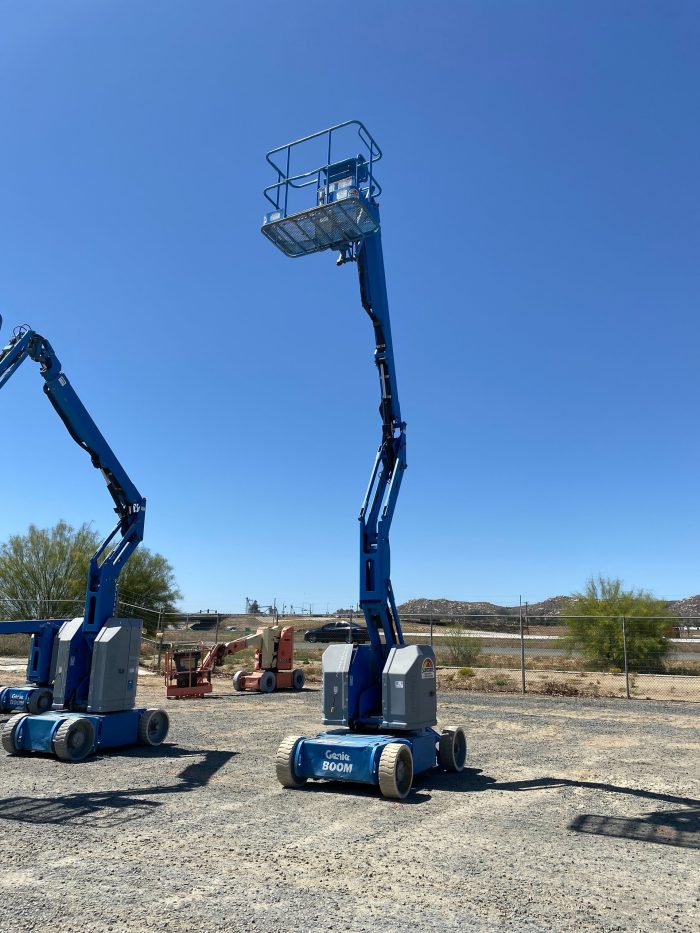Boom lifts have transformed the way many jobs are done and have made working at height much safer and more efficient. If you are working on a job site that could benefit from the use of a boom lift, be sure to talk to your supervisor about renting or purchasing one for the duration of the project.
What is a boom lift?
A boom lift is a type of aerial platform used to provide temporary access for people or equipment to difficult-to-reach areas. Boom lifts are commonly used in the construction industry, but are also used in a variety of other industries including event management, window cleaning, and film production.
Boom lifts vary in sizes and shapes, but all share a common design – a platform suspended from a boom arm that is raised and lowered using a hydraulic system. The boom arm can be either telescopic or articulating, and the platform can be either enclosed or open.

Boom lifts can be powered by either electricity or petrol, and can be either wheeled or tracked. Tracked boom lifts are often used in rough terrain, while wheeled boom lifts are more suited to smooth surfaces.
What are its uses?
Boom lifts are typically used for two main purposes – to provide access for people to work at height, or to provide a platform for equipment such as cameras or lights.
In the construction industry, boom lifts are commonly used to provide access for workers to carry out tasks such as painting, repairs or maintenance. They are also used to lift heavy materials or equipment to the upper floors of a building under construction.
In the event management industry, boom lifts are used to provide a temporary platform for lights or speakers at outdoor events. They are also commonly used to hang banners or flags at sporting events or concerts.
In the film industry, boom lifts are used to raise cameras or lights to get the perfect shot. They are also used to provide access for crew members to difficult-to-reach areas on set.
Window cleaners also use boom lifts to access the upper floors of buildings. The platform on a boom lift can be fitted with a water tank and hose, making it the perfect tool for cleaning the outside of tall buildings.
Boom lifts are an essential piece of equipment for a variety of industries. They are safe, versatile, and efficient, and can be used to access a wide range of difficult-to-reach areas.
How heavy can a boom lift hold?
Most boom lifts have a weight capacity of between 1,000 and 1,500 pounds. However, some models can hold up to 2,000 pounds. The weight capacity of a boom lift depends on the model and the manufacturer.
What are the different types of boom lifts?
A boom lift is a mechanical device used to provide temporary access for people or equipment to inaccessible areas. There are three main types of boom lift:
1. Telescopic boom lift:
A telescopic boom lift has a telescoping arm that can be extended and retracted to reach high or low areas. This type of boom lift is often used in construction and industrial applications.
2. Articulating boom lift:
An articulating boom lift has a hinged arm that can be pivoted to reach around obstacles. This type of boom lift is often used in tree-trimming and other applications where a high degree of maneuverability is required.
3. Extendable boom lift:
An extendable boom lift has a telescoping arm that can be extended and retracted. This type of boom lift is often used in warehousing and other applications where a high degree of reach is required.
How to determine the right size of the boom lift needed for a job?
When considering what size boom lift you need for a job, there are a few things you’ll need to take into account. The first is the reach you need, which is determined by the height of the objects you’ll be working with and the distance they are from the base of the lift. The second is the capacity you need, which is determined by the weight of the objects you’ll be working with. Finally, you’ll need to consider the terrain you’ll be working on and whether or not the boom lift will be able to maneuver safely.
Once you have a good understanding of the reach and capacity you need, you can start to narrow down your options by looking at the different sizes of boom lifts available. Boom lifts typically come in four different sizes: Compact, Mid-Size, Large, and Extra-Large.
Compact boom lifts are typically used for indoor applications or for working in tight spaces. They have a smaller footprint and can be easily maneuverable, but their reach is limited.
Mid-size boom lifts are a good option for most applications. They have a larger reach than compact lifts and can still be easily maneuverable.
Large boom lifts are typically used for outdoor applications or for working with heavy objects. They have the largest reach of all the boom lift sizes and can be more difficult to maneuver.
Extra-large boom lifts are the largest option and are typically used for very heavy objects or for working in extremely tall spaces. They have the largest reach and are the most difficult to maneuver.
Once you’ve considered the reach and capacity you need, as well as the terrain you’ll be working on, you should have a good idea of what size boom lift you need. If you’re still not sure, it’s always a good idea to consult with an EWP hire company to get their expert opinion.